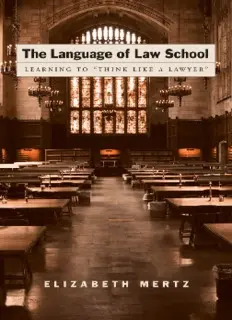
Learning to “Think Like a Lawyer” PDF
Preview Learning to “Think Like a Lawyer”
The Language of Law School This page intentionally left blank The Language of Law School Learning to “Think Like a Lawyer” Elizabeth Mertz 1 2007 3 Oxford University Press, Inc., publishes works that further Oxford University’s objective of excellence in research, scholarship, and education. Oxford New York Auckland Cape Town Dar es Salaam Hong Kong Karachi Kuala Lumpur Madrid Melbourne Mexico City Nairobi New Delhi Shanghai Taipei Toronto With offices in Argentina Austria Brazil Chile Czech Republic France Greece Guatemala Hungary Italy Japan Poland Portugal Singapore South Korea Switzerland Thailand Turkey Ukraine Vietnam Copyright © 2007 by Oxford University Press, Inc. Published by Oxford University Press, Inc. 198 Madison Avenue, New York, New York 10016 www.oup.com Oxford is a registered trademark of Oxford University Press All rights reserved. No part of this publication may be reproduced, stored in a retrieval system, or transmitted, in any form or by any means, electronic, mechanical, photocopying, recording, or otherwise, without the prior permission of Oxford University Press. Library of Congress Cataloging-in-Publication Data Mertz, Elizabeth, J.D. The language of law school : learning to “think like a lawyer” / Elizabeth Mertz. p. cm. Includes bibliographical references and index. ISBN-13 978-0-19-518286-6; 978-0-19-518310-8 (pbk.) ISBN 0-19-518286-3; 0-19-518310-X (pbk.) 1. Law—Study and teaching—United States. 2. Law—United States—Methodology. I. Title. KF279.M47 2007 340.071'173—dc22 2006045325 1 3 5 7 9 8 6 4 2 Printed in the United States of America on acid-free paper . . For my daughters, Jenny and Becca This page intentionally left blank Preface This is a study whose genesis dates back to the day I first took my seat in a Con- tracts classroom as a first-year law student, and that came to fruition as I for the first time taught Contracts to first-year law students. Having participated in both ends of the process has added depth to my understanding of the law school experience. As a first-year student, I took notes in my Contracts class in two col- umns; the first kept track of the concepts my professor was endeavoring to im- press on us, and the second was a running anthropologist’s commentary on the studies that someone should do to investigate the social and linguistic processes at work in contract law—and in legal reasoning generally. This work is an initial ef- fort to investigate the distinctive shape of a core U.S. legal worldview, empirically grounded in the study of the language through which law students are trained to this new approach. During the first year of law school, students are reputed to undergo a trans- formation in thought patterns—a transformation often referred to as “learning to think like a lawyer.” Professors and students accomplish this purported transfor- mation, and professors assess it, through classroom exchanges and examinations, through spoken and written language. What message does the language of the law school classroom convey? What does it mean to “think” like a lawyer? Is the same message conveyed in different kinds of schools, and when it is imparted by profes- sors of color or by white women professors, and when it is received by students of different races, genders, and backgrounds? This study addresses these questions, using fine-grained empirical research in eight different law schools. This page intentionally left blank Acknowledgments In a fashion that ought to please followers of Carol Gilligan, I began composing the acknowledgments to this volume long before I started the book itself. This was because I have at all points felt deeply how much the work depends on a web of relationships, on the contributions of so many people to whom I feel profoundly indebted. Before I attempt to do justice to this rich relational context, let me thank two institutions, the American Bar Foundation and the Spencer Foundation, for the generous funding that made this project possible. Some of the material from Chapter 2 is reprinted by permission of The Yale Journal of Law and the Humani- ties, Vol. 4, pp. 168–173; portions of Chapter 4 appeared originally in Natural Histories of Discourse, edited by Michael Silverstein and Greg Urban (University of Chicago Press, pp. 229–249; © 1996 by The University of Chicago. All rights re- served). Chapter 6 contains material from Language Ideologies: Practice and Theory, edited by Bambi Schieffelin, Kathryn Woolard, and Paul Kroskrity (pp. 149–162, used by permission of Oxford University Press; © 1998 by Oxford University Press), as well as material that is revised by permission from Democracy and Ethnography: Constructing Identities in Multicultural Liberal States, edited by Carol J. Greenhouse (The State University of New York Press, pp. 218–232; © 1998 by State University of New York. All rights reserved). Thanks to the editors who worked on these materials with me as well as to those who helped with articles to which I retained copyright and from which I have drawn in this volume, which appeared in the Journal of Legal Education 48(1): 1–87 (with Wamucii Njogu and Susan Gooding), and the John Marshall Law Review 34(4): 91–117. I am also grateful to the many colleagues—anonymous reviewers as well as many who are named below—who have read and commented on parts of or all of the manuscript. Greg Matoesian and Stewart Macaulay graciously provided thorough reviews of the linguistics and
